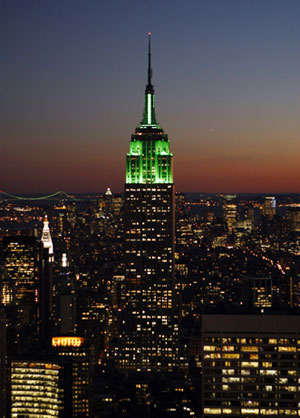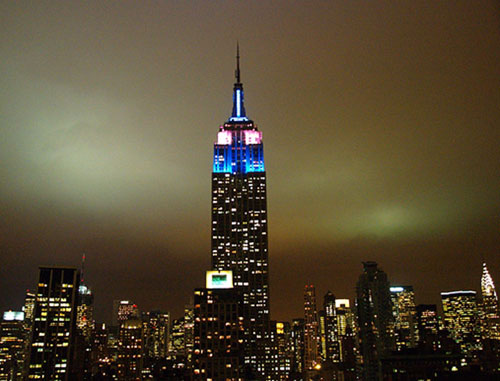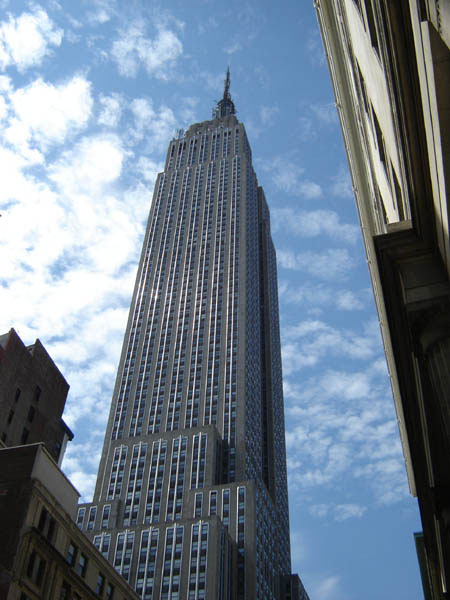It is so obvious, so cliché and so visible that visiting the Empire State Building gets, ironically, overlooked. Like the single slice meal, blue Yankee cap and yellow cab, the skyscraper is in the city’s DNA, so familiar you feel as if you have been there even if you have never stepped foot on the observation deck. Or maybe you have written it off as an over-priced tourist trap, which is not entirely off-base. But as the gray monolith turns 80 years old on May 1, it is worth giving it a second — or first — try.
The Empire State Building inspires the imagination, its views are the highest and best in the city, its history revelatory, and makeovers to the lobby and observatories deserve a fresh look. All you need to do is avoid the headaches and traps of a visit so that nothing detracts from the marvel.
Avoiding the lines
There are four famously-lengthy lines (tickets, security, elevator up, elevator down) but there are just as many ways to avoid them. You can visit during more predictably crowd-free times, particularly between the 8 am opening and the pre-lunch rush, and after midnight until the 2 am close. For other times, call ahead. I scored a lineless visit on a Wednesday just before sunset by calling 212-736-3100 and asking for the wait time. If the estimate exceeds your patience you can purchase an Express Ticket for $24 extra and get the velvet rope treatment at the front of each line. Or, for only a $2 online fee, you can at least buy and print out the normal ticket in advance and avoid the ticket line, which is often the longest.
With those hurdles leapt you are free to enjoy the gleaming lobby, nearly half a block of prime Art Deco design. The illuminated celestial-meets-industrial scene of gold and aluminium leaf spheres and lines, modern by 1930s standards, had been obscured for decades by florescent lights that were modern by ’60s standards. Its recreated glory, accomplished by historical architects and artisans, is classic Gotham. It left me feeling woefully underdressed without a fedora and pinstripe suit.
The bar
The Empire Room, an old-school-styled cocktail lounge of mohair, velvet, ebony and embossed leather that opened last year, extends that retro feel. The vibe is reminiscent of the early ’60s-set television show Mad Men, though the soundtrack alternated between appropriate Harry Connick Jr tunes and mood-shattering Sade and Queen remixes. The cocktail menu includes classics such as the Ramon Gin Fizz, Waldorf and Martinique Daisy, all elaborately and proficiently executed.
The bar’s signature drink is a sweet, bubbly variation on the Empire State Cocktail — gin, vermouth, Royal Combier Liqueur, lemon juice and raspberry-orange marmalade crowned tableside in a chilled martini glass with Moet & Chandon champagne. As an aside to the bartender shaking mine out, one pearl-necklaced hostess characterized the concoction as “stupid”. And while it is an admittedly convoluted, fruity concoction Don Draper would not be caught dead sipping, the champagne was a nice addition to the classic recipe. It gave me a fizzy rush that aped the ascent of the building’s dizzying height.
 History
History
When you are ready to head up the city’s tallest building (and the world’s tallest for about half of its 80 years), move quickly through the photo booth, past the Kevin Bacon-voiced virtual “Skyride”, and hop into the marble elevators up, up and away. As you soar 1,050 feet to the observatory deck on the 86th floor, consider the giant office building’s unlikely history.
“How high can you make so it won’t fall down?” John Jacob Raskob, Empire’s builder, asked its architect, William Lamb, as the story goes. This would have been around the peak of the stock market in the late 1920s when everything must have seemed possible. But construction (on the site of what was once the fabled Waldorf-Astoria hotel) began just months after the 1929 crash. Counter-intuitively, this aided its construction. The lucky-to-be-employed workforce efficiently built it in a little more than a year (at times as rapidly as a floor a day), with steel girders still hot from Pennsylvania mills, riveted together 15 to 20 hours after they were forged.
Born in the roaring boom of Icarus-like speculation that soon crashed to earth, this phoenix of the Great Depression gave locals in the nation’s crippled financial capital symbolic hope in the bleak year of 1930. Empire became a totem of the city in many ways: classic, resilient and ambitious, thriving on the confidence that it can survive the city’s travails. And like the experience of so many New Yorkers, this lighthouse of commerce had rough times, especially in the beginning. Less than half occupied when the building opened, it was nicknamed “The Empty State Building” and took about two decades to become profitable. In its first year it managed to just cover expenses from the observatory’s $2 million revenue.
Like falling in love
“This…is…amazing.” “Oooh!” “Wow!” “Oh my god!” “Wee!” “Look at that!” “Crazy!” “¡Manifique!”
Those were some of the wide-eyed reactions of my fellow visitors as we stepped off the elevator at the 86th floor. We took in 360 degrees of unobstructed views – the five boroughs, the bridges and rivers, the ocean, even downtown (a sight denied at the top of Rockefeller Center, blocked by Empire). On a clear day you can see 80 miles and five states and on an overcast one you are floating in the clouds, detached from the world below. It is impossible to take a bad picture from up there.
On a visit in April the temperature was only a few degrees cooler than the ground and not windy on the lee side. I watched the sun set over New Jersey and then saw Manhattan twinkle to life as dusk settled.
You get lightheaded and floaty being outside at that height, a bit like falling in love, which is probably why Empire is the scene ender in classic love stories like An Affair to Remember, Sleepless in Seattle (in homage to Affair) and King Kong (yes, it is a love story). The observation desk is also witness to proposals of marriage almost daily, according to unofficial tallies. The building even hosts an annual essay contest for couples looking to get married on the 86th floor.
I must have been feeling something like love, because I shelled out another $15 for the more exclusive and slightly better view from the 102nd floor. The elevator up the spire is manually operated and represents its progression in feet, not floors. As we ascended, I thought again of the building’s history – how the original intent of the 17-story high spire was as a dirigible anchor and passenger gate. The current top observation deck at 1,250 feet is enclosed, but in the original plans it was an outdoor platform where you loaded on and off trans-Atlantic dirigibles parked over midtown. The 86th floor was where you would have bought your blimp tickets, had the plan not been permanently scuttled by high winds.
From the top deck you take in the quiet, miniature city. New York is adorable from that height, and puzzling. It seemed far too small to encompass so many different lives, rising and falling fortunes, history and myths. The peaks and valleys of the southern tip put the grid in bas relief. Looking down on the nearby Chrysler Building and the nose of the Flatiron Building was unreal, like Google Earth or tilt-shift photography jumping into reality. I scanned for Brooklyn’s tallest building, the old Williamsburg Savings Bank, which had towered over my old apartment, and it was a mere toothpick from that vantage point. Once you descend back to the surface of the city, you will never look at it quite the same again.
The lights of midtown’s lighthouse
Even if you have never scaled the Empire State Building and witnessed the view, most visitors enjoy the reverse — marvelling at its illuminated semaphore-ish calendar. Credit goes to real life Mad Man Douglas Leigh who gave us such classics as the Times Square smoking Camel sign. His idea was to make Empire a weather alert and talked Coca-Cola into sponsoring the endeavour by printing a guide to the colour system on their bottles, until post-Pearl Harbor blackouts interfered with the plan. In 1976 he tried again and the building was lit red, white and blue for the nation’s bicentennial. After that success a colour scheme was devised for major holidays and now good causes (Japanese disaster relief and Parkinson’s awareness, for example) and occasionally more esoteric and commercial honorifics like purple/purple/yellow for the Westminster Kennel Club. The full lighting schedule can be found at www.esbnyc.com.
David G Allan is the editorial director of BBC Travel.
Thank : bbc.com

